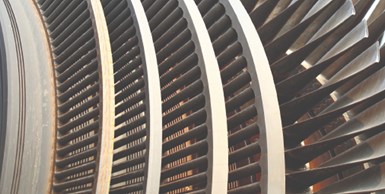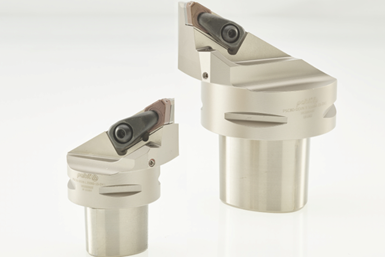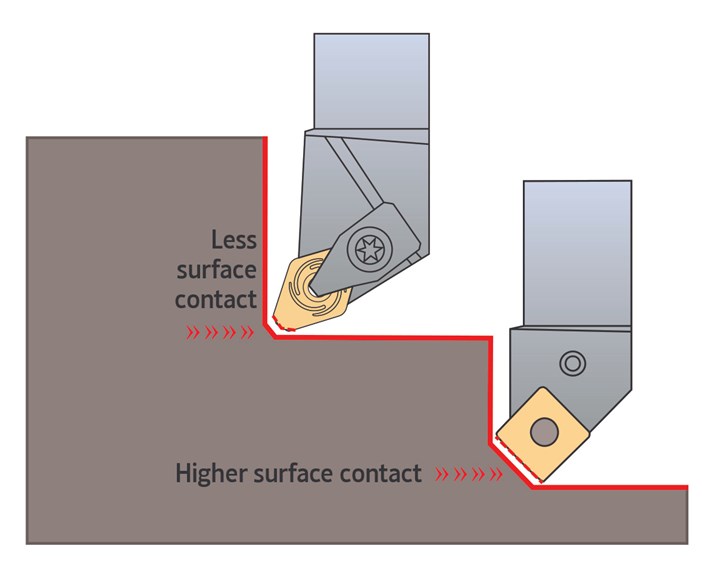Heat-resistant superalloys (HRSA) are highly dense metals composed of nickel (Ni), iron-nickel (Fe2Ni) — including nickel steel or stainless steel — cobalt (Co) and chromium (Cr) that can be used at temperatures up to 70% of their melting points, ranging from 1,900°F (1,050°C) to 2,200°F (1,200°C). Although HRSA resistance to corrosion and heat make them well suited for applications in aerospace, defense, general machining, marine, medical/biomedical, oil and gas, petrochemical and power generation industries, they generally have poor machinability characteristics.
This is due to those materials’ high hot hardness and strength, high dynamic shear strength, low thermal conductivity, austenitic (NiCr or NiFeCr) matrix, hardening during machining, abrasiveness and common formation of built-up edge on an insert. In continuous cuts such as turning, manufacturers often use ceramic inserts for roughing due to their hardness because they can typically cut faster than carbide inserts. However, ceramic inserts do not have the toughness required to handle corners or interrupted cuts, which is far from ideal when used to rough-machine HRSA.

Heat-resistant superalloys (HRSA) are highly dense metals that have poor machinability characteristics, making rough-turning operations challenging. (Photo Credits: Palbit SA)
To provide manufacturers with a more efficient way to machine HRSA, Palbit SA (a Portugal-based, vertically integrated manufacturer of carbide tooling) developed DOMX heavy roughing inserts. Pilot Precision Products, of South Deerfield, Massachusetts, became the exclusive U.S. master importer of Palbit carbide cutting tools in 2022.
The letters D, O, M and X are taken from the ISO insert designation chart. D corresponds to the insert’s shape (rhombic 55 degrees); O is the clearance (relief angle) designation which, in this instance is “other” to signify a new design not reflected in letters A-G, N and P; M denotes the tolerance class (nose height, inscribed circle and thickness in millimeters); and X symbolizes the insert’s geometry (special design).
DOMX inserts are made of solid carbide, come in a single size #4 size, are PVD coated and well suited for medium-to-rough turning of HRSA because they combine high hardness with high heat-resistance properties. A DOMX insert features four positive cutting edges on a double-sided negative insert and can reduce cycle times to varying degrees while increasing tool life by as much as 140%.

DOMX inserts must be used with Palbit SA’s proprietary right- or left-hand holders. The inserts are made of solid carbide, come in a single size and feature a PVD coating.
The chip breaker geometry enables DOMX inserts to provide the same impact as a high feed insert but with a lower amount of surface contact to minimize head and cutting pressure. As a result of that design feature, DOMX can take a heavy cut and generate low amounts of heat in the cut, enabling the insert and the workpiece to retain their respective shapes and properties.
The inserts give shops the option of using high-speed, high-feed roughing in a single-pass operation.
DOMX approaches into corners faster than alternative tooling. It also finishes the cut without failing — as opposed to what can happen with ceramic inserts when machining HRSA because those inserts lack toughness and get overheated when used at variable speeds.

According to Palbit SA, DOMX inserts can approach faster than alternative tooling and finishes the cut without failing as can happen with ceramic inserts when machining HRSA.
In short, DOMX inserts gives shops the option of using high-speed, high-feed roughing in a single-pass operation. Specifically, they enable a 45-degree insert lead angle to produce a higher depth-of-cut in rough or medium turning applications. They can be used for facing, external or internal turning, case machining and ring machining while offering cycle time reduction, tool life improvement and stability in the roughing process at a lower cost than ceramic inserts.
Tool Setup Tips
DOMX is a patented insert design and must be used with Palbit’s proprietary right- or left-hand holders. To achieve the optimal setup for an application, the lead angle should be as close as possible to 45 degrees based on the workpiece shape. By creating a 45-degree lead angle, tool life can be increased by 30% or more. A 45-degree lead angle also increases cutting force, improves rigidity and reduces deflection. Although chatter or tool deflection might occur, shops will still likely experience higher material removal rates and increased productivity.
Shops can determine the largest possible radius for dispersing the effects of cutting forces, reducing notch wear and decreasing the probability of insert breakage by performing calculations on one’s own or with assistance. With so many variables involved, an engineering conversation is likely to be necessary before deciding whether DOMX inserts are optimal for a given application.
Related Content
Making Micro Threads
Production of micro threads can be challenging, but using the most suitable tools for a given application can simplify the task.
Read MoreWhat Is Trochoidal Turning? How Might Shops Benefit From It?
While trochoidal milling might be a more well-known toolpath strategy, trochoidal turning can offer similar benefits such as high material removal rates especially for rough-turning operations.
Read MoreBroaching Tool Technology For Lathes Used to Slot Inconel Parts
This shop finds value in using an indexable-insert-style broaching tool to create blind-hole slots in heat-treated Inconel aerospace parts on a CNC lathe.
Read MoreBoring Head Enables Sculpture Hardware to Be Machined on a Lathe
When small job shop Ansonia Manufacturing took on a tricky hardware component job for a “live” glass art sculpture, it realized a boring head would be needed to machine the part complete on its live-tool lathe.
Read MoreRead Next
Keeping Your Tool Cool From the Inside Out
Dual internal coolant channels in this parting off/grooving tool are said to provide greater cooling capability than external flood coolant delivery.
Read MoreTips to Make CNC Machining Tool Failure Predictable
Accurate prediction of tool life is key to establishing a controlled, repeatable and reliable CNC machining process.
Read More4 Strategies for Managing Chip Control
Having strategies in place for managing chips is an important part of protecting the production process, from tool life to product quality.
Read More.png;maxWidth=970;quality=90)











.png;maxWidth=300;quality=90)










